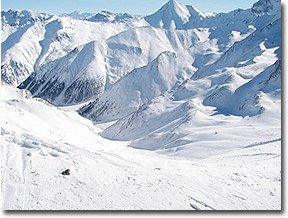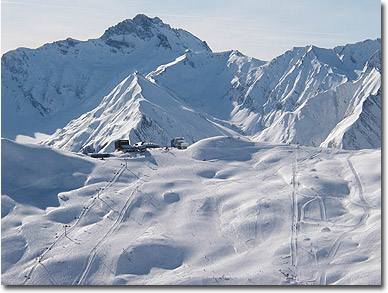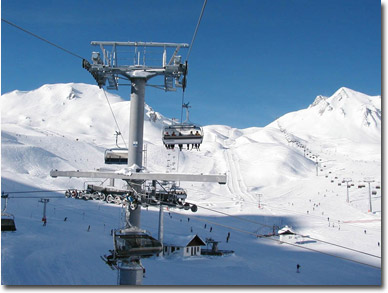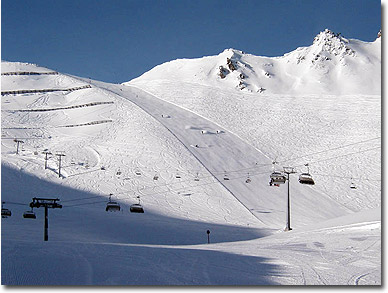Editor’s Note: DCSki Columnist John Sherwood just returned from a 13-day, 3-resort ski safari of Austria and Switzerland. This report, on Ischgl in Austria, is the first of three articles on this trip, describing his experience in Austria January 28-31, 2004. (His second report focuses on Sölden, Austria, and his third report focuses on St. Moritz, Switzerland.)
 Ischgl is completely off the radar screen for most North American skiers. In my four days there, I only ran into one American group. For Europeans, however, this resort is a top destination on the continent. Why? Ninety percent of its 205 kilometers (127 miles) of prepared trails are located between 2,000 and 2,872 meters (6,561 and 9,422 feet) above sea level. The high altitude of this terrain makes Ischgl one of the most snow-sure resorts in the entire Alps. If that were not enough, Ischgl has invested over €100,000,000 ($126,880,000) in recent years to create one of the most modern lift systems in the world. The huge number of high-speed, detachable, bubble chairs, high-speed gondolas, and modern trams at Ischgl ensure that guests rarely if ever see a lift line. Idalp, the resort’s mid-mountain base station, is literally the Metro Center of lifts. When you emerge from one of the three village access gondolas and arrive at the snowy Idalp basin (2,300 meters/7,545 feet), you are confronted by 6 modern chair lifts radiating in every direction from the gondola stations. To quote DCSki columnist Jim Kenney, “Big lifts equal big fun!”
Ischgl is completely off the radar screen for most North American skiers. In my four days there, I only ran into one American group. For Europeans, however, this resort is a top destination on the continent. Why? Ninety percent of its 205 kilometers (127 miles) of prepared trails are located between 2,000 and 2,872 meters (6,561 and 9,422 feet) above sea level. The high altitude of this terrain makes Ischgl one of the most snow-sure resorts in the entire Alps. If that were not enough, Ischgl has invested over €100,000,000 ($126,880,000) in recent years to create one of the most modern lift systems in the world. The huge number of high-speed, detachable, bubble chairs, high-speed gondolas, and modern trams at Ischgl ensure that guests rarely if ever see a lift line. Idalp, the resort’s mid-mountain base station, is literally the Metro Center of lifts. When you emerge from one of the three village access gondolas and arrive at the snowy Idalp basin (2,300 meters/7,545 feet), you are confronted by 6 modern chair lifts radiating in every direction from the gondola stations. To quote DCSki columnist Jim Kenney, “Big lifts equal big fun!”
I flew out of DC on a snowy Tuesday night on January 27 to Vienna, Austria (VIE). Despite being delayed five hours at Dulles, Austrian Airlines made sure that seats were reserved on a later shuttle flight from Vienna to Innsbruck (INN), and more importantly, that my bags also made the later connection. The 45-minute shuttle from VIE to INN is pure pleasure. If you are lucky, you will fly a turboprop rather than a jet, allowing for much better views of the Austrian Alps. As I gazed out the window, I could not help but notice how snowy the mountains appeared. The Alps had received four days of periodic snow prior to our arrival, ensuring that conditions would be superb.

|
|
|
It took my wife and I less than two hours to drive from Innsbruck to Ischgl. We stayed in the Hotel Salnerhof, an exquisite four-star establishment just steps away from the town’s main gondola, the Silvrettabahn. At Ischgl, most guests eat both dinners and breakfasts at their hotels. This “half pension” system makes the real cost of a room much cheaper than the cover price might suggest. Our meals at Salnerhof were five course affairs prepared by a culinary school trained chef. Each day, we had a choice of three main entrees (meat, seafood, or vegetarian) plus an appetizer, salad bar selections, a cheese course, and dessert. The food at the hotel was continental cuisine at its best and compared very favorably to some of Washington’s better restaurants. Arguably, my cod dish one night was just as delicious as a cod entrée I ordered just a few weeks before at Woodley Park’s New Heights restaurant.
Our first day of skiing at Ischgl was our only bad weather day. As usual, I woke up early that day, poked my nose out the window, noticed the snow and grey skies and promptly went back to bed. We didn’t make it up to Idalp until ten and -14 Celsius (6.8 Fahrenheit) temperatures and poor visibility above the tree line kept us on easy slopes. We’d hang out in the lodge sipping hot chocolate, wait until visibility improved a bit, and then ski a relatively short, 440 meter/1,443 feet vertical run near the Idalp plateau. Eventually, we found some good, tree-lined slopes on the Paznauer side of the mountain. As a general rule of thumb, skiers should seek lower, tree-lined runs on low visibility days in the Alps because trees provide much needed contrast. Fortunately, Ischgl has extensive tree-lined territory below both sides of Idalp -; some of which are quite steep and long. Skiers can bag 920 meter/3,018 foot vertical runs from Idalp to the village.

|
|
|
The next day was a true blue bird: sunny skies, perfect snow, and smiling faces everywhere. We easily logged 40,000 feet of vertical on this truly epic day. We began our journey by taking a series of high-speed lifts to the top of Palinkopf mountain (2,864 meters/9,396 feet), and then playing on the 38-degree, north facing headwalls of the mountain. You know a headwall is steep when you create small avalanches behind you as you make turns. At Ischgl, I rented Atomic SL-9s -; skis that were good for short-radius turns but not wonderful for GS, open throttle skiing. On the black 21 trail I would have preferred the, harder Volkl Superstar 6 skis I rented at St. Moritz because this slope was empty and extremely wide -; just the type of hero terrain that can make an upper level intermediate feel like Bode Miller for a day.
After a few warm-up runs, we charged down the number 80 trail to the Swiss town of Samnaun. Ischgl and Samnaun share a common lift pass, known as the Silvretta Arena card -; a chip card that opens turnstiles at both resorts. For a few Euros more, one can also buy a pass good not only at Ischgl and Samnaun but the neighboring resorts of Galtur, See, and Kappl. In short, one could easily spend a week in the area and rarely ski the same trail twice. The 80 trail down to Samnaun (1,840 meters/6,036 feet) is a classic, big mountain decent that covers miles of terrain and 1,024 meters/3,359 feet of vertical.
Anyone comfortable skiing Upper Cupp Run at Snowshoe should easily be able to handle most of the red (intermediate runs) terrain at Ischgl. Those comfortable with Bold Decision at Whitetail should be able to handle most of the blacks as well. Ischgl grooms nearly all of its marked pistes daily, making steeper descents very accessible to most intermediates. I would only warn timid intermediates to avoid some of the high-altitude catwalks such as the number 15 trail linking Greitspitz (2,872 meters/9,422 feet) with the Hollenkar area. Although not very steep, the red (intermediate) 15 trail is narrow and unfenced. If you skied off the edge in spots, you would end up being Seth Morrison for a day (i.e. cliff diving).
Samnaun is a much quieter place than Ischgl -; perfect for families wishing to get away from the occasionally intense après ski scene at Ischgl. It connects to the Silvretta Arena via a unique, double-decker, 80-person tram. At the end of the day, this tram can get crowded, so skiers wishing to visit Samnaun are advised to go early. The Samnaun tram takes skiers to Alp Trida (2,263 meters/7,424 feet), a high bowl surrounded on all sides by mountains between 2,488 meters/8,162 feet and 2,872 meters/9,422 feet in height. One could spend an entire day at Alp Trida and barely ski all the terrain accessible from this high base. I enjoyed the red trails radiating down from Viznitzkopf. 60 percent of trails at Ischgl are red, making this an ideal resort for strong intermediates.
We spent the final part of our first day exploring the trails on the far right side of Palinkopf. These trails are slightly steeper and narrower than the reds found at Idalp and Alp Trida, making them good testing slopes for advanced intermediates. By the end of the day, the trails also had small but soft bumps, giving me a wonderful opportunity to take advantage of my Atomic slalom skis. The highlight of the day was skiing from Palinkopf (2,864 meters/9,396 feet) all the way down to Ischgl (1,400 meters/4,593 feet) -; a 1,464 meter/4,803 foot vertical evolution! That’s five times the vertical of Whitetail.

|
|
|
Exhausted would be an understatement to describe my physical condition after a day of big mountain skiing at Ischgl. Fortunately, Salnerhof offered a variety of warm water pleasures to sooth body and soul. I enjoyed the subterranean pool with its waterfall and whirlpool areas.
My wife and I are not huge après ski fanatics. We ski hard, sleep, and then ski hard again. However, no article on Ischgl would be complete without some comment on the party scene at Ischgl. Austria has a reputation for offering some of the best après ski in the Alps. Like St. Anton, the après ski begins early in the day at the various mountain huts lining the lower trails of the mountains. By 3 pm, expect to see people dancing on tables to Euro pop music. My wife and I got a huge chuckle at the Gampenalp hut when they played the Dutch group Hermes House Band’s version of John Denver’s Country Roads. West Virginia all of a sudden seemed much closer.
The party continues until about 8 pm at the many bars in the village of Ischgl. There is then a two-hour break for dinner followed by more revelry at the town’s various night bars and discos. As in most ski towns, the ratio of men to women is weighted heavily to the advantage of women, but that does not seem to discourage anyone from partying until the wee hours of the morning.
For us, however, sleep was more important because we had many more kilometers of runs to make before we left Ischgl. One of the most interesting was the 7 trail from Pardatschgrat to Velilltal. This trail appears relatively short on the map, but is huge in actuality. Since few people ski it, the piste gives one a taste of some of the ample backcountry to be found in the Silvretta Alps. For freeriders, Silvretta compares favorably to the Arlberg. After the snow, we saw plenty of backcountry snowboarders making huge, Craig Kelly style rooster tails as they descended impossibly steep terrain off the many lift served peaks of the Silvretta. Those wishing to “go big” and experience backcountry skiing can hire a mountain guide through Ischgl’s tourist board. I’m not a backcountry skier, so I was content to view the terrain from the safety of the marked pistes -; many of which give one the experience of backcountry riding without the dangers and difficulty.
In all, I only skied Ischgl for four days and left feeling that I had only sampled a small portion of this amazing ski region. Although we skied most of terrain above Ischgl and Samnaun, we never made it to Galtur, See, or Kappl. We also rarely waited in a lift line. In fact, the only semblance of a wait was at the beginning of each day at the Silvrettabahn’s gondola station and this line never lasted longer than ten minutes. Getting to Idalp from the town used to be a problem but the new, 16-person, high-speed Silvrettabahn, along with the two older 4-person gondolas, is handling crowds well.
Ischgl, a town of just 1,500 citizens, is one of the newest ski arenas in the Alps. Its first cableway was constructed in 1963 and now it offers 42 lifts and can accommodate over 10,000 guests. What is more, the resort is not finished. In the future, Ischgl plans to open up even more terrain in the Fimbatal/Piz Val Gronda area near the Swiss border. I enjoyed the place tremendously and would rank it as a top ski spot in the Alps.
Photos provided by John Sherwood.
John Sherwood is a columnist for DCSki. When he's not hiking, biking, or skiing, he works as an author of books on military history.